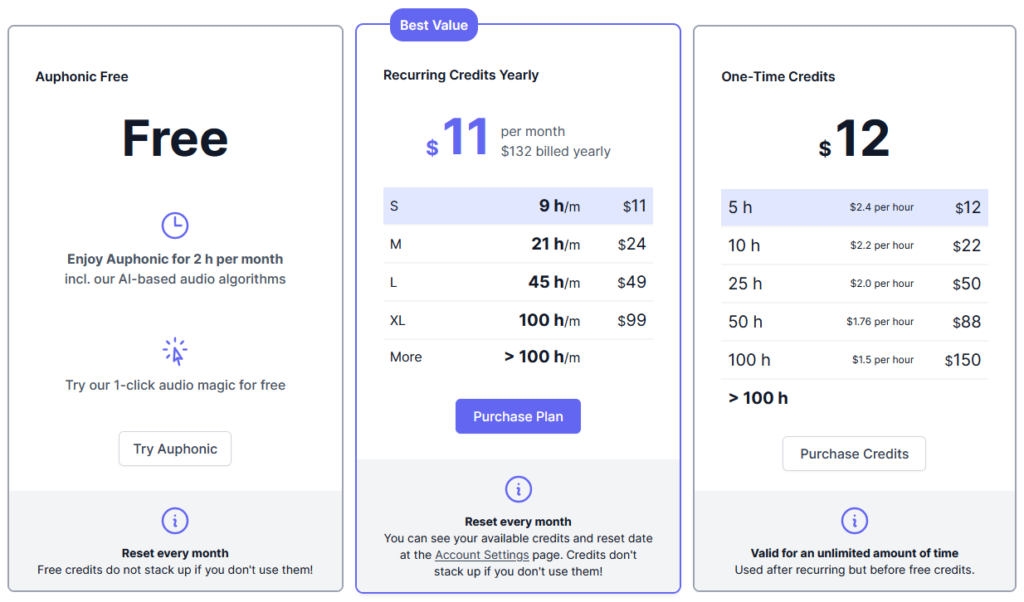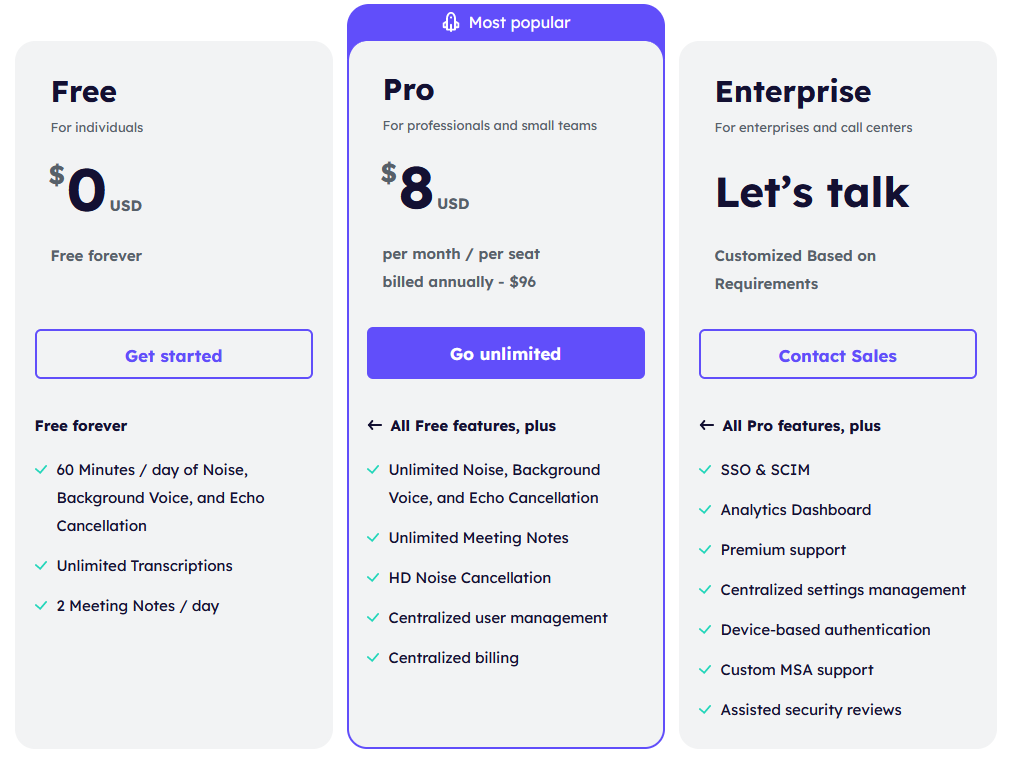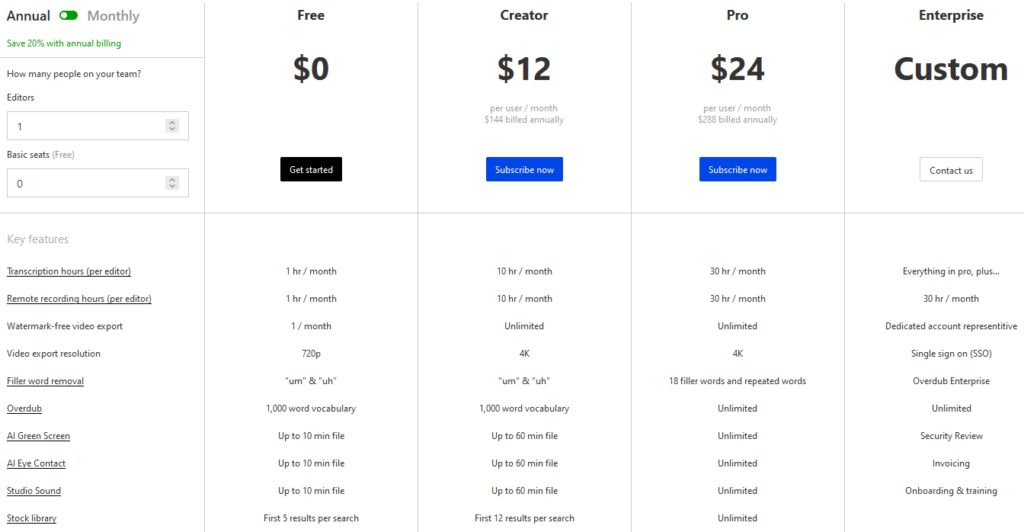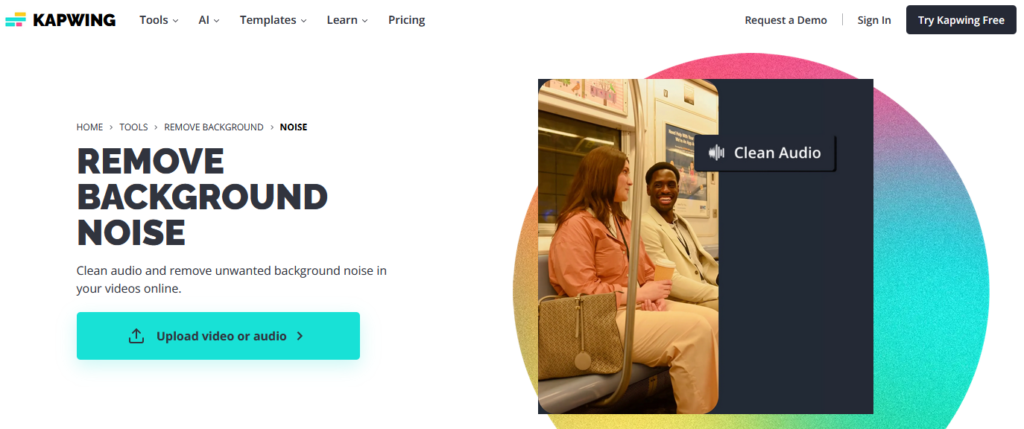Why Use AI Audio Enhancers?
In the bustling world of audio, where podcasting is rapidly becoming the go-to medium for storytelling and information dissemination, the demand for impeccable sound quality is higher than ever. AI audio enhancers are stepping up to meet this demand. Beyond the realms of traditional audio software, these AI-driven tools offer unparalleled precision in sound refinement, making audio noise removal a breeze.
Whether you’re a seasoned podcaster aiming to deliver crisp narratives, an audiophile in pursuit of the purest sound, or simply someone seeking an ambient noise-free musical experience, AI audio enhancers have got you covered. Join us as we delve deep, reviewing the best in AI audio solutions and exploring how they’re revolutionizing the soundscapes of our digital age. Welcome to the sonic renaissance!
1. Auphonic
Overview
Auphonic offers a revolutionary audio post-production service that employs a blend of AI and signal processing techniques to simplify and streamline the mastering process. This platform stands out as a tool for individuals producing content for mediums like podcasts, YouTube, radio shows, and films, ensuring that the audio quality is top-notch. A significant advantage of Auphonic is its ability to equalize audio levels between speakers and optimize both single and multi-tracks. Furthermore, it boasts features like noise elimination, loudness normalization, and seamless integration with cloud services. The platform’s prowess lies in its capability to save users valuable time by automating intricate post-production tasks, without demanding prior expertise from the user. With its easy-to-use interface, available both on desktop and mobile apps, Auphonic provides a seamless experience for enhancing audio quality across various content types.
Key Features
- Enhanced Audio Features: Auphonic offers tools to add professional touches like intros and outros, set chapter markers, and automatically adjust sound levels for consistency.
- Optimal Audio Quality: Utilize advanced algorithms for tasks like noise and hum reduction, loudness normalization, and adaptive leveling to maintain balanced and clear sound throughout.
- Time-saving Presets: Customize your preferred settings and save them as presets for quicker and more consistent production in the future.
- Versatile Workflows: From multitrack algorithms to automatic content deployment, Auphonic supports a range of processes for different audio needs.
- Transcription Services: The platform provides automatic speech recognition for creating transcripts, enhancing accessibility for diverse audiences and aiding in content description.
- User-friendly Integration: Seamlessly work with external cloud storage providers like Google Drive and Dropbox, making content transfer and editing straightforward.
- Chapter Breaks: Define and mark distinct segments within your audio or video content, enabling listeners to navigate easily to specific topics or segments.
- Advanced Noise Management: Address background noise effectively, allowing for a more professional-sounding output, while providing flexibility in the level of noise removal applied.
- Balanced Sound Levels: The intelligent leveler helps harmonize audio levels between various speakers and between speech and music components.
- Accessibility and Inclusion: Prioritize inclusivity by transcribing content, making it available to a wider audience, including those with hearing impairments.
Pricing

Pros and Cons
Pros
Cons
Bottom Line
Auphonic stands out as a remarkable AI audio tool, tailored for those not versed in the intricacies of audio mastering. Offering affordability and user-friendliness, it’s a game-changer for podcasters and video editors, streamlining the audio-editing process and ensuring consistent sound quality. While it’s a trusted ally in most situations, users should be cautious with highly complex or poor-quality audio files, as the tool’s efficacy can diminish. Despite this slight limitation, Auphonic is invaluable, especially for budding podcasters. Relying on it can save not just money, but also the daunting task of mastering intricate audio adjustments. In essence, for anyone venturing into the realm of podcasting or audio editing, Auphonic is a noteworthy recommendation, ensuring superior post-production outcomes.
2. Krisp
Overview
Krisp emerges as a revolutionary AI-driven noise-cancellation software, adept at filtering out background disturbances during calls. By leveraging a sophisticated Deep Neural Network, Krisp can discern over 20,000 noises, ensuring clarity by effectively distinguishing between human voices and ambient sounds. This local on-device processing assures users of their audio’s privacy, eliminating any concerns about data being transmitted to the cloud. Such prowess, coupled with its compatibility with over 800 applications spanning from voice messaging to conferencing, positions Krisp as an indispensable tool for both macOS and Windows users. Not just a virtual shield against distracting noises, its adaptability also ensures it works seamlessly across an array of devices, from microphones to speakers. Renowned platforms like Forbes and TechCrunch have recognized its innovative approach. Simplified yet powerful, Krisp’s interface lets users activate noise-cancellation with a single click, furthering its appeal as a user-friendly solution. As users continue to engage with Krisp, the AI-enhanced mechanism evolves, promising even sharper noise discernment over time.
Key Features
- Efficient Noise Elimination: Krisp effectively diminishes background noises, such as construction sounds, ensuring that only the user’s voice is audible during calls. This efficiency applies to both outgoing and incoming audio.
- Universal Compatibility: Krisp can seamlessly integrate with various conferencing platforms including Zoom, Skype, and Google Hangouts, allowing flexibility in communication.
- Broad Device Pairing: The software can be effortlessly paired with a diverse range of devices like microphones, headsets, or speakers, catering to both stationary users and frequent travelers.
- Cross-Platform Functionality: Krisp is accessible on a variety of operating systems like Mac, Windows, and iOS. Additionally, there’s a Chrome Extension available for those seeking a web-based option.
- Utmost Privacy Assurance: With all noise-reduction processes happening on the user’s device, Krisp ensures audio isn’t recorded or transmitted to external servers, prioritizing user privacy.
- Industry Recognition: Krisp has carved a niche for itself as a leading expert in noise cancellation, offering impeccable sound quality even in environments teeming with distractions.
- Dynamic AI Capabilities: The software’s AI can be tailored to specifically recognize an individual’s voice, filtering out other surrounding voices. This feature can be particularly beneficial in bustling spaces like call centers.
- User-Friendly Design: Krisp’s interface is intuitively designed, facilitating easy setup and toggling between audio inputs without a clutter of excessive options.
Pricing

Pros and Cons
Pros
Cons
Bottom Line
Krisp has emerged as an indispensable tool for remote workers, especially for those operating from unpredictable environments. This app ensures you maintain a professional demeanor in all virtual interactions, be it team meetings or interviews. After experiencing the clarity it offers, it’s hard to recall the disturbances that once plagued audio calls. The newfound peace during calls means no more apologies for intrusive background noises or repeated requests for clarifications. In essence, Krisp elevates the quality of virtual communication, making it efficient and hassle-free.
3. Descript
Overview
Diving into the podcasting realm? Descript is your AI-enhanced partner, ensuring seamless audio and video editing experiences. Imagine tweaking your podcast episodes just like editing a Word document; that’s the magic Descript brings. Born from the world of audio editing, its transformative leap into video showcases its comprehensive capabilities. Noteworthy features like the Shorten word gaps and Remove filler words tools streamline audio perfection. Collaboration gets a nod too, with shared editing tools. Enhancements like the Overdub feature don’t just mimic but truly capture the user’s voice, refining its precision with each uploaded content. From screen recordings to instant publishing, Descript ensures both newbie podcasters and seasoned pros have a platform that’s as intuitive as it is powerful. Simply put, it’s where simplicity meets unmatched podcasting prowess.
Key Features
- Record multiple tracks at once, enriching sessions with intros, outros, music, and effects.
- Advanced transcribing offers real-time edits for recorded audio, enhancing live sessions.
- The unique Wordbar feature facilitates easy adjustment of space between words on the timeline.
- Rich audio editing tools, from AI-powered room tone generation to precise mic bleed detection.
- Incorporate multiple project timelines, optimizing organization of raw data and drafts.
- Real-time collaborative editing, bolstered by an automatically updated cloud media library.
- Tailored media clips with animated captions cater to diverse social media platforms.
- A player with interactive transcripts for sharing on Descript’s customizable pages.
- Seamlessly publish to multiple podcast platforms, streamlining distribution efforts.
- Comprehensive export flexibility ensures compatibility with a variety of editing platforms.
Pricing

Pros and Cons
Pros
Cons
Bottom Line
In wrapping up this review, it’s clear that Descript stands at the forefront of revolutionizing podcast editing with its advanced AI capabilities. It seamlessly merges intuitive text-based editing with sophisticated audio and video processing, making it a game-changer for both novice and seasoned podcasters. The tool’s AI-driven features, from transcription accuracy to automatic room tone generation, showcase its commitment to simplifying the production process without compromising on quality. While there’s a learning curve to master its myriad features, the payoff in saved time and enhanced production quality is undoubtedly worth it. For anyone looking to elevate their podcasting journey, leaning into the future with Descript’s AI prowess seems like an unquestionable choice.
4. LALAL.AI
Overview
LALAL.AI stands out as a cutting-edge AI-driven tool tailored for intricate audio manipulation. By harnessing sophisticated machine-learning methods, it proficiently divides audio tracks into distinct components, including vocals and instrumentals, unlocking a vast potential for diverse applications from music production to crafting karaoke tracks. The recent introduction of their Voice Cleaner tool further underscores their commitment to innovation, providing users, from journalists to musicians and beyond, an efficient solution to eliminate background distractions from recordings, ensuring enhanced vocal clarity. While they promote their product as a “zero audio quality loss” solution, our analysis aims to discern its actual efficacy. Offering an intuitive interface and a vast AI database, LALAL.AI promises not only clear audio separation but also an easy user experience for professionals and enthusiasts alike.
Key Features
- Stem Splitting: LALAL.AI offers a potent stem splitter tool, enabling users to isolate vocals and instruments from diverse audio or video sources, paving the way for innovative audio remixes and modifications.
- Voice Purification: The Voice Cleaner function harnesses AI to extract lucid voice tracks by minimizing background disruptions and ensuring vocal-centric clarity, ideal for acapella or professional track creation.
- Mobile Accessibility: LALAL.AI provides a user-friendly mobile app for iOS, allowing on-the-go audio editing and stem extraction with just a few screen interactions.
- Efficient AI Algorithm: Their in-house, top-tier AI algorithm stands out by almost entirely eliminating background noise and magnifying voice clarity, even under noisy conditions.
- Broad Format Compatibility: The platform seamlessly supports myriad audio and video formats, negating the need for multiple conversions and simplifying noise reduction processes.
- Generous Upload Capacity: Users can upload substantial files up to 2GB, with varying minutes limits based on the subscription plan.
- Stem File Downloads: Premium users enjoy the privilege of downloading Stem files, diving deeper into isolated audio segments, ideal for precise audio projects.
- Business Integration: LALAL.AI’s Voice Cleaner can be smoothly integrated into online platforms via an API, with robust privacy measures, tailored scaling options, and dedicated support for optimized operations.
Pricing

Pros and Cons
Pros
Cons
Bottom Line
In conclusion, LALAL.AI stands out with its impressive audio processing capabilities, offering a user-friendly interface that prioritizes simplicity. While some advanced producers might desire a more intricate approach to simultaneous stem separation, the platform’s cloud-based, pay-as-you-go model provides exceptional value, particularly for those not needing daily use. Moreover, for those seeking deeper musical control, it’s advisable to explore additional tools. Yet, given LALAL.AI’s comprehensive features, free trial availability, and efficient online audio editing prowess powered by AI, it’s undeniably a commendable choice for those seeking quality audio solutions without breaking the bank.
5. Kapwing
Overview
Kapwing, a renowned online platform, promises to transform the editing experience with its plethora of tools. Aimed at catering to both newcomers and seasoned professionals, this platform is especially beneficial for educators and marketers. Enhanced by AI technology, Kapwing simplifies many tasks, from video editing to meme crafting and audio noise reduction. Its user-centric design encourages collaborative efforts, allowing multiple users to tackle a project in tandem. Although it’s predominantly touted as a video editing tool, its diverse audio features, like noise removal, can’t be overlooked. As we dive into this review, we’ll explore whether Kapwing, despite its versatility, can truly stand as a rival to professional audio software or if it’s best suited for those seeking quick, uncomplicated solutions.
Key Features
- Premium Audio Features:
- Remove Background Noise: Kapwing’s standout tool ensures studio-like audio quality by effortlessly eliminating unwanted background sounds.
- Voiceover Generation: Use AI to craft voiceovers with human-like inflections and emphasis, even if you don’t want to record it personally.
- Automatic Transcription: Swiftly transcribe video content for the creation of subtitles or to facilitate content repurposing and search.
- Clear Audio Output: Achieve engaging videos with sharp sound quality, sidestepping the complexities of traditional audio mastering.
- Smart Silence Detection: The “Smart cut” function autonomously identifies and removes silent patches from your content.
- Text-to-Video Integration: Edit your videos efficiently by modifying the text transcript, allowing alterations without tedious manual timeline adjustments.
- AI-Enhanced Content Creation: Leverage Kapwing’s AI technology for efficient content design, especially tailored for social media.
- Advanced Video Editor: Beyond audio, Kapwing’s video editor comes packed with features like animations, blur effects, and speed adjustments.
- Cloud-Centric Collaboration: Share, collaborate, and edit with teams on any device, making content creation more unified.
- Direct Sharing and Distribution: Easily distribute your audio or video content across platforms without redundant downloading.
- Rich Template Collection: Benefit from a diverse array of templates enhancing Kapwing’s content creation suite.
Pricing

Pros and Cons
Pros
Cons
Bottom Line
Kapwing, a trusted content creation platform by renowned companies like Spotify and Google, boasts a commendable reputation, showcased by its glowing reviews across the internet. A key highlight of this tool is its user-friendliness; its free version is practical, though it does impose a watermark on exports. In our tests, Kapwing’s noise reduction for audio files stood out, effortlessly erasing background disturbances without sacrificing the primary audio’s quality. While it lacks the intricate customization some professionals might seek, its simplicity serves users aiming for efficient audio clean-up. Despite not being an all-encompassing audio editor, its foundational editing tools have won over a user base exceeding a million, with notable mentions in Forbes, Mashable, and TechCrunch. To sum it up, for those in search of a straightforward solution to audio disturbances, Kapwing emerges as a competent and recommended choice





